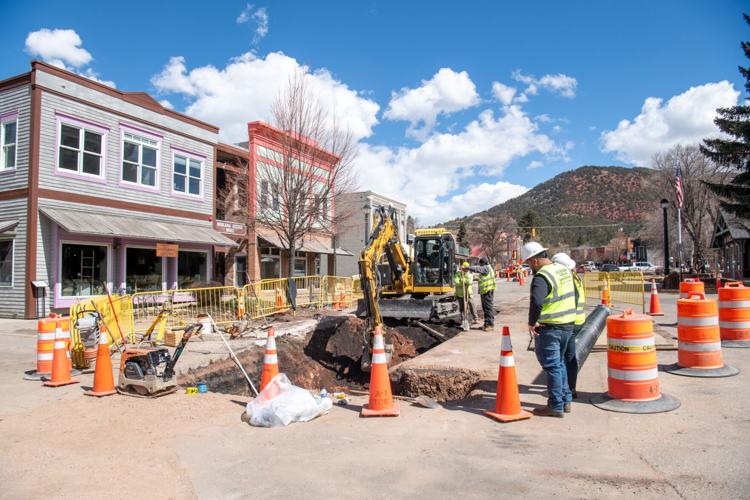
Workers with Stutsman Gerbaz Earthmoving replace infrastructure along Basalt’s Midland Avenue last week. They found old rails from the Colorado Midland Railroad buried under the street.
An interesting relic of Basalt’s railroad history was uncovered during the Midland Avenue Streetscape project earlier this month.
A crew from Stutsman Gerbaz Earthmoving uncovered rails used by the Colorado Midland Railroad while digging up Midland Avenue near its intersection with Midland Spur on March 20. Basalt Town Engineer Catherine Christoff said two sections of track at an estimated 15 feet each and two pieces estimated at 8 feet each were unearthed.
“This is by far the most significant finding that we’ve come across,” Christoff said.
Pictures posted on the town’s Facebook page shows workers using equipment to hoist the rails out of a trench a couple of feet deep.
There are a lot of sources of information on Basalt’s railroad history, among them the book “Basalt: Colorado Midland Town” by native sons Clarence and Ralph Danielson. In its recap of Midland Railroad history, they wrote that the first railroad buildings were constructed in the area, then known as Aspen Junction, in 1886. The rail lines were connected in town on Nov. 5, 1887.

A picture posted on the Town of Basalt Facebook page shows workers hoisting old rails after excavating Midland Avenue last week. The Colorado Midland Railroad stopped operating in 1918, suggesting the rails are over a century old.
A map included in the book depicts the town as it was laid out in 1900, with the railroad tracks paralleling Railroad Street, which is now Midland Avenue. Branches of the railroad headed toward Glenwood Springs and Aspen. There was a huge wye in the area where Midland and Midland Spur now come together. Within the wye were the depot, now the Alpine Bank building, and just to the west was a roundhouse, a circular building used for servicing and storing locomotives.
Photos of downtown Basalt from that era show a tangle of tracks, infrastructure and buildings to service the locomotives and cars. Aspen Junction was renamed Basalt in 1895 and the town was incorporated in 1901.
The Colorado Midland Railroad had a relatively short life. The last passenger train to leave the station was on Aug. 4, 1918. The last freight train operated a short time later, according to the Danielsons. The rails were torn up in 1921.
It’s unknown why the standard-gauge rails discovered this week weren’t ripped up with others. So far, that’s about all the railroad infrastructure that’s been unearthed by the modern public works project.
“They haven’t found a lot,” Christoff said. “We were hoping for more.”
Rumor had it that tunnels existed beneath what is now Midland Avenue that connected a hotel, where Tempranillo restaurant is now located, to saloons on the other side of the tracks. The tunnels allegedly were built for discreet passage for ladies of the night, Christoff said. Alas, the fabled passages haven’t been found. The map with the Danielsons’ book shows that Kelly’s Saloon and Lupton Saloon were side-by-side on the north side of Railroad Street, across from the hotel.

A map from the book “Basalt: Colorado Midland Town” shows the layout circa 1900. The rails were found last week close to the 73 on the map.
Underground work will progress east on Midland Avenue as the year goes on so more artifacts could be found. It appears that the standard-gauge rails that were found are at least 104 years old and probably older. The lifespan for rails depends on their level of use, according to multiple online sources. The Midland was financially strapped as early as 1912, so it isn’t likely any rails were replaced after that time. The rails that were found could conceivably date back to 1887.
The discovered treasures are currently piled up in the snow outside of Basalt Town Hall. They show the wear-and-tear from more than a century but are very much intact.
“We’re going to keep them and do something, maybe art,” Christoff said.
Commenters on the post on the town’s Facebook page urged that the rails be incorporated into an existing historic walking tour of the town. Christoff told the Town Council on Tuesday that there will be future discussions on what to do with the rails.
The streetscape project is designed to make the town’s main street more pedestrian-friendly and create places for people to gather. Some design features will give a nod to Basalt’s railroad heritage. Inlaid brick will have the dimensions and the curve of one of the rail lines as it passed in front of what is now Tempranillo, Christoff said.
The Midland Avenue Streetscape Project is scheduled to continue throughout 2024.




